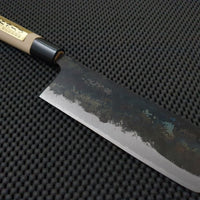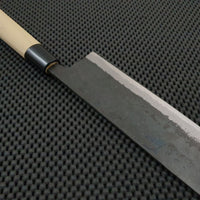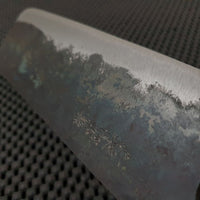





It's been 11 years since we saw this line last. One of the first carbon steel knives we imported into Australia in large numbers, they still represent one of the best entry points into traditional Japanese knives.
- Kiyotsuna Saku Japanese Kitchen Knife
- 165mm Nakiri Knife
- SK5 High-Carbon, Soft Iron Clad
- D-Shaped Ho Wood Handle w/ Plastic Ferrule
(more comfortable for right-hand use) - Kurouchi Finish
- Crafted in Japan
- Edge Length: 160mm | Overall Length: 304mm | Blade Height: 53mm | Weight: 171g
- Blade Thickness: (A) 3.6 (B) 2.4 (C) 1.7 (at spine)

* As our Japanese chef knives are hand-made, small variations in size and appearance may occur, and measurements and images are a guide only.
* High-carbon steel kitchen knives will change colour (patina) during use, care is required to prevent rust.

Japanese Kitchen Knife | Nakiri (Vegetable Knife)
Nakiri knives are a specialist Japanese vegetable cutting knife that can also be used as your primary kitchen knife, depending on your cutting style.
Nakiri knives have a flat profile and tall blade height which aids in push chopping but does make rock style cutting a little uncomfortable. The Nakiri, like many western style chef knives has a double bevel grind, in contrast to the Japanese style vegetable knife, the Usuba, which is single bevel. Whilst a Gyuto or Santoku does do a good job at cutting vegetables, the larger flat bottom of a Nakiri or Usuba make the task much easier. The Nakiri is one of our favourite profiles, highly recommended.
Nakiri knives have a flat profile and tall blade height which aids in push chopping but does make rock style cutting a little uncomfortable. The Nakiri, like many western style chef knives has a double bevel grind, in contrast to the Japanese style vegetable knife, the Usuba, which is single bevel. Whilst a Gyuto or Santoku does do a good job at cutting vegetables, the larger flat bottom of a Nakiri or Usuba make the task much easier. The Nakiri is one of our favourite profiles, highly recommended.






